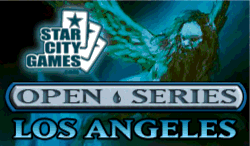Legacy is going to be gangbusters in 2010. There are fifteen $5K Legacy tournaments being put on by StarCityGames.com. That’s just the icing on the Legacy cake. Wizards of the Coast will be giving away $60,000 in two Grand Prix tournaments. Nine of the SCG $5K opens will be held before Grand Prix: Columbus at the end of August. This could very well be the largest year for Legacy ever.
There is going to be so much money on the line. Not to mention, doing well in the Legacy events will qualify you for not only the Pro Tour, but for the SCG Invitational.
The Legacy metagame will shift into overdrive. The incentives will never be stronger to really break Legacy, to find metagame gaps, opportunities, and engage in metagame arbitrage. No one in their right mind will be ignoring this format. Grand Prix: Chicago, the last North American Legacy Grand Prix, smashed previous Grand Prix attendance records, and chances are very good that Columbus will break that record once again.
In this article I will do a number of things. First, I will take a very close look at the most recent SCG $5K Legacy Open results. I will take a look at what people brought into battle. Then I will look at how these decks performed by graphing Top X% penetration (Top 16, Top 8, Top 4 penetration, and so forth).
My second major task will be to put these results in perspective, as we come to the end of the year. I will show how these archetypes have been trending over the year. There has been four SCG $5K’s this year, all since Grand Prix: Chicago. I will show you how each major archetype has been trending over that time.
Third, I will take a hard look at how these archetypes perform, not just in the field, but against each other, using the matchup grid I created for the last SCG results, and new results from the St. Louis Open.
Finally, I will suggest what I see was metagame opportunities and gaps. I will suggest some archetypes as particularly well suited to the metagame going forward.
Aiding me in all of this is Jared Sylva. Jared Sylva sent me the SCG St. Louis Open decklists. He and a colleague put together a wonderful spreadsheet showing the results of the Legacy Open. Using the decklists, I’ve corrected some of the archetype names, and aggregated the results below.
SCG $5K St. Louis
128 players
15 Dredge
11 Merfolk
11 Canadian Threshold
10 Countertop-Goyf
8 White Stax
8 B/G Suicide (Eva Green)
6 BGW
5 Ad Nauseam
5 Zoo
4 43 Land
4 Aggro Loam
3 Goblins
3 Reanimator
3 Entomb Hulk
2 Affinity
2 Dreadtill
2 Survival
2 Burn
2 G/U Aggro-Control
2 Landstill
2 Scepter Chant
1 Elspeth Control
1 Dark Depths Combo (BRG)
1 Slivers
1 Team America (UBG Tombstalker-Goyf, Tempo)
1 Gifts Control
1 Pox
1 Bant Loam
1 Dragon Stompy
1 Enchantress
1 GWU Aggro-Control
1 Mono-White Beatdown
1 Polymorph
1 Elves
1 Natural Order Elves
1 RU Stax
1 Jace Control
Here’s what the results look like graphically:
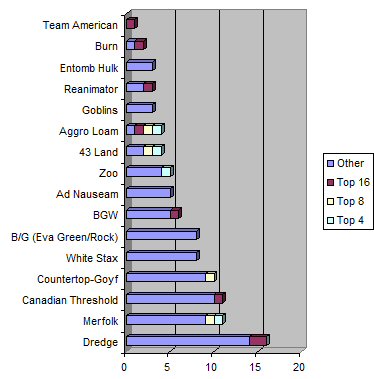
Here’s another way to look at this data:
| Archetype | % of Field | % in Top 16 | % in Top 8 | % in Top 4 |
| Dredge | 11.8% | 13.3% | 0 | 0 |
| Merfolk | 8.6% | 18.2% | 18.2% | 9.1% |
| Canadian Threshold | 8.6% | 9.1% | 0 | 0 |
| Countertop-Goyf | 7.8% | 11.1% | 11.1% | 0.0% |
| White Stax | 6.3% | 0.0% | 0.0% | 0.0% |
| B/G (Eva Gr/Rock) | 6.3% | 0.0% | 0.0% | 0.0% |
| BGW | 4.7% | 16.7% | 0.0% | 0.0% |
| Ad Nauseam | 3.9% | 0.0% | 0.0% | 0.0% |
| Zoo | 3.9% | 20.0% | 20.0% | 20.0% |
| 43 Land | 3.1% | 50.0% | 50.0% | 25.0% |
| Aggro Loam | 3.1% | 75.0% | 50.0% | 50.0% |
| Goblins | 2.3% | 0.0% | 0.0% | 0.0% |
| Reanimator | 2.3% | 33.3% | 0.0% | 0.0% |
| Entomb Hulk | 2.3% | 0.0% | 0.0% | 0.0% |
| Burn | 1.6% | 50.0% | 0.0% | 0.0% |
| Team American | 0.8% | 100.0% | 0.0% | 0.0% |
That table very clearly shows the best performing archetypes. You can compare percentage of the field versus Top X penetration.
Winners:
Although Team America had the greatest proportion of itself represented in the Top 16, the only copy in the tournament, it didn’t crack the Top 8.
The best performing deck was Aggro Loam. There were only 4 Aggro Loam decks in the tournament, and half made Top 4, with three quarters making it into the Top 16.
The next best performing archetype was 43 Land.dec. Not only did 50% of the 43Land decks make Top 16, each of those made it into the Top 8, and 25% in the Top 4.
There is a steep drop after Aggro-Loam and 43 Land, but the third best performing deck was Zoo. Zoo put 20% of its players into the Top 4 despite only being 4% of the field.
The fourth best performing was Merfolk, which was 8.6% of the field, but 18.2% of the Top 8.
Aggro Loam and 43 Land.dec dominated this tournament, despite being tiny in numbers. I will explain why in a bit.
Losers:
B/G decks, both Eva Green and The Rock, were surprisingly poor choices. Also, White Stax, the previous winner, was also a very poor choice. Those decks collectively made up over 12% of the field, but couldn’t put a single player into the Top 16, let alone the Top 8.
Another poor choice was Ad Nauseam, which was 4% of the field, but put up a big goose egg in the Top 16.
Entomb Hulk was a much smaller part of the field, but it appeared to be an awful choice. Collectively, here’s how the three Hulk pilots faired:
Lost to Burn, Lost to Merfolk, Lost to Threshold, Drew with Stax, lost to CounterTop-Goyf, Lost to GUW, lost to Dragon Stompy. Collectively, the three Entomb Hulk decks only had two victorious matches: a match against Reanimator and Dredge. That seems like a deck to avoid.
In the Middle:
These decks weren’t bad, but they weren’t good either.
Dredge is probably at the top of this list. It was the most popular deck, at 12% of the field, and it was proportionally represented in the Top 16, but had no one in the Top 8.
Canadian Threshold is in the same boat. It performed pretty much the same as Dredge did, representing itself in the Top 16, but putting no one in the Top 8.
BGW (Junk) did very well, in terms of Top 16 penetration, but it couldn’t put anyone in the Top 8.
Countertop-Goyf also slightly overperformed, both in terms of Top 16 and Top 8. It wasn’t a bad choice either.
Now that we have a sense of how these archetypes performed in the most recent large scale event, let’s delve a little bit deeper, an archetype at a time.
Dredge
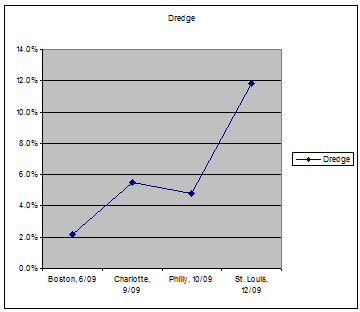
This is the percentage of Dredge decks in the field at each of the SCG Opens this year. Dredge was a miniscule part of the field in back in June, at SCG Boston. It hovered around 5% until this gigantic leap to 12% in St. Louis. I can only begin to explain why.
The performance of Dredge in Philly can’t explain this uptick. It was thoroughly mediocre in Philly. I think a big factor has to be Zendikar, and Bloodghast in particular. I could see that creating an uptick, but this leap was enormous. It went from being tied for the 6th most popular archetype to the flat most popular archetype.
In my matchup grid, I showed that Dredge’s performance did not seem to correlate to archetype, but suggested that it was probably a function of graveyard hate.
The data this time seems to confirm.
Here is Dredge’s matchup record against major archetypes:
CounterTop-Goyf: 4-1
Merfolk: 1-2
Threshold: 4-5
Stax: 2-2-1
Aggro Loam: 0-4
Junk: 1-0
Zoo: 2-3
B/G: 2-2
Ad Nauseam: 1-1-1
As before, this is a thoroughly mixed bag, with one glaring exception. Apparently, Dredge loses to Aggro-Loam, which undoubtedly helps explain, a tiny bit, why Aggro-Loam did so well.
Dredge’s matchups against the entire field are very un-Legacy-like, in the sense that most Legacy matchups, as we saw in my last Matchup Grid, are clear and distinct one way or the other. Not so with Dredge.
Going forward, I would think that Dredge would be an awful archetype to play. Given:
1) Dredge was the most popular deck
2) Aggro Loam was the best performing deck
3) Land was the second best performing deck
You can imagine that all of the incidental hate for Aggro Loam and Land is going to hit Dredge even harder.
Merfolk
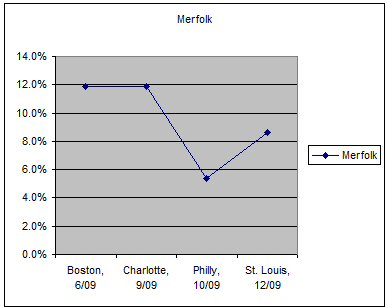
Merfolk entered the field post-GP Chicago as one of the best performing and most popular decks, since it was so successful at beating up Countertop-Goyf decks.
Finally, the metagame adjusted, and in Charlotte Zoo showed up in huge numbers, and Merfolk players got smashed. That’s why Merfolk fell so steeply from Charlotte to Philly.
You’ll recall from my matchup Grid from Philly that every single time a Zoo pilot faced a Merfolk Pilot in Philly, the Zoo pilot won. Every single time.
Zoo was the best performing deck in Charlotte, so of course people were going to steer clear of Merfolk. However, the metagame adjusted, somewhat, and in Philly, Zoo had trouble against a host of archetypes. As a result, the metagame was much more conducive to Merfolk in St. Louis. There were only five Zoo decks in the entire tournament. That undoubtedly helped Merfolk.
How did Merfolk do this time? Let’s see:
Zoo: 1-5
Ad Nauseam: 2-0
CounterTop-Goyf: 2-2
Aggro Loam: 0-3
Junk: 3-3
Threshold: 1-2
43 Land: 1-1
Dredge: 2-1
Stax: 2-2
B/G: 0-3
Well, Merfolk is no more successful at beating Zoo than it was in the last tournament. Sam Black, one of the Merfolk pilots who made Top 8, lost to Zoo in the Top 8.
Here is what we can say:
Merfolk loses to Zoo and B/G. It beats Ad Nauseam, and splits with CounterTop-Goyf and Threshold.
This is the same data as we saw in the last tournament. This information would ward me off from Merfolk. I wouldn’t play a deck that loses pretty much every time to one of the most popular archetypes, Zoo, and only splits with the two big Blue decks, Threshold and CounterTop.
CounterTop-Goyf
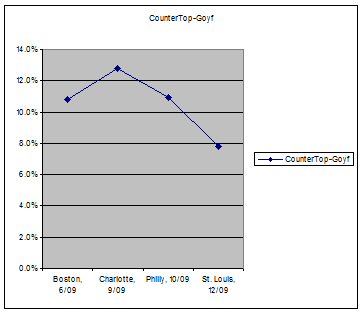
Until now, CounterTop-Goyf has consistently been the first or second most popular archetype in the field. Now, it’s fallen to fourth. However, it’s still a deck to beat. The problem is that there are so many variants.
How did CounterTop fare against the field? Here are the results:
Merfolk: 2-2
Threshold: 3-2
Junk: 1-1-1
Stax: 1-2
Aggro Loam: 0-1
B/G: 1-1
Dredge: 1-4
Ad Nauseam: 1-0
43 Land: 1-2
Zoo: No Players Faced
These results don’t tell us as much as the previous tournament results. But they still tell us some important information. In particular, Countertop decks are splitting with Threshold and Merfolk.
Interestingly, they are losing to the Graveyard decks, and I think it’s easy to understand why. The Countertop deck is probably conserving its sideboard space to deal with predators like Zoo and Merfolk, and in the process has little room for Dredge or Land.
Countertop, if it can keep these matchups and shore up the graveyard deck matchups, it should be able to perform well in the future. There is nothing in its matchup grid that would disqualify CounterTop from being able to win a tournament like Zoo does for Merfolk or Aggro-Loam does for Dredge.
Zoo
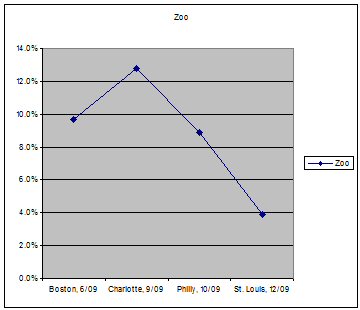
Zoo was the fourth most popular archetype in Boston, and shot way up in Charlotte. It’s been falling every since, but I have a feeling it is on the rebound, especially given the results of the most recent tournament:
Merfolk: 5-1
Ad Nauseam: 2-1
Stax: 1-0
Threshold: 1-2
Junk: 0-1
B/G: 1-1
Aggro-Loam: 0-2-1
It’s too bad that Zoo didn’t face CounterTop-Goyf, but in the previous tournament, it went 5-8-3, slightly unfavorable. What is favorable is Merfolk, and Merfolk is the second most popular deck. Also, interestingly, the 2-1 against Ad Nauseam suggests that it may have found ways to win that matchup, a matchup it could not win in Philly.
I think Zoo is a deck that will rebound in LA. Here is the key: make sure you have anti-graveyard cards in your SB, and I think Zoo is well positioned to make Top 8 in LA.
Canadian Threshold
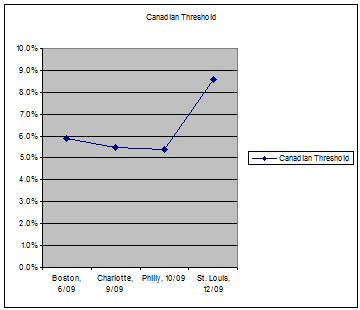
Canadian Threshold is a constant presence, and one of the top Decks to Beat in Legacy. It doesn’t dominate tournaments, but it doesn’t have any unwinnable matchups either, which is part of its allure. It’s not like Zoo or Merfolk, with terrible individual matchups.
Here’s how Canadian Threshold did this time:
Zoo: 2-1
Merfolk: 2-1
Countertop-Goyf: 2-3
B/G: 2-0
Junk: 1-2
Aggro-Loam: 2-3
Stax: 0-1
Dredge: 5-4
Canadian Threshold is the 50% deck. It can beat anything, but it doesn’t have any lopsided matchups. It’s not a bad choice for the next tournament, but if the goal is to exploit metagame gaps, I would not select this deck.
White Stax
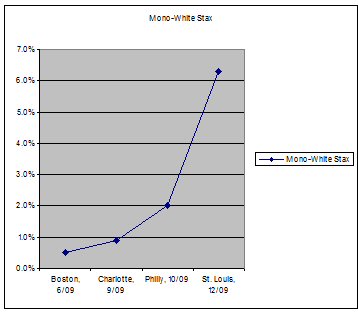
Stax won the last SCG $5K open, and that’s why we saw such a huge uptick in its performance. And, as with Zoo, and other previous top contenders, the response was equally devastating.
The lesson here is pretty simple: do not play a deck that has won the previous tournament. It will be hated out.
Look at what happened to Stax:
Threshold: 1-0
Countertop-Goyf: 2-1
Zoo: 0-1
Merfolk: 2-2
43 Land: 0-1
B/G: 2-0
Ad Nauseam: 2-0
Aggro-Loam: 0-1
Dredge: 2-2-1
There aren’t a lot of results here to tell you much, but the fact that no Stax decks made Top 16 tells us what we need to know the most.
Aggro-Loam
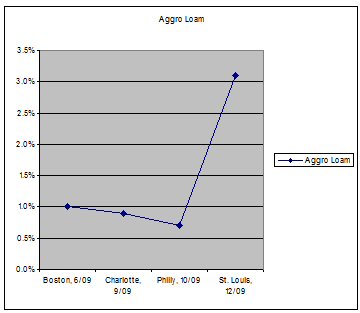
As you can see, and not unlike, say, White Stax, Aggro-Loam has been a tiny part of the field. But, like White Stax did after its win, I fully expect Aggro Loam to shoot up to 6.5+% of the field in LA. It could even be as much as 8-9% of the field. Stax went from 2% of the field to 6.25%. I see no reason why Aggro Loam wouldn’t see as tremendous a rise.
So, what explains Aggro-Loam’s success?
Here’s how it performed:
Dredge: 4-0
Zoo: 2-0-1
Merfolk: 3-0
CounterTop-Goyf: 1-0
Stax: 1-0
Canadian Threshold: 3-2
Now you can see what’s going on here.
My theory is this: Aggro Loam straddles the metagame at a very important point: it’s strong against Merfolk and Zoo, which is why I think people brought it.
Consider the metagame in Philly. We know that Merfolk is targeted at the Blue decks, but only splits with them, or is slightly favorable. But it’s very popular. Zoo beats Merfolk.
So, the solution? Find the deck that can beat both Zoo and Merfolk. In fact, I believe that is the straddle point of Legacy. If you can find the deck that beats both Merfolk and Zoo naturally, then you can tune your deck from there.
Aggro Loam not only beats Zoo and Merfolk, but it crushes Dredge, the most popular archetype. Aggro Loam was a good choice going in, but it became a great choice inadvertently, with the huge surge of Dredge.
But what beats Aggro Loam? Precious little, it seems. Pat McGregor didn’t lose to anyone. And the other Aggro Loam player in the Top 8 only lost to Pat. Brian Boss’s only match loss gives us a clue: He lost to Eva Green. The other two Aggro-Loam pilots lost to 43 Land twice, Threshold, and Landstill.
Expect massive amounts of graveyard hate in LA. Expect Leyline of the Void all over the place. I would not play Aggro-Loam, but I would be darn sure that I play a deck that can compete with or naturally defeats Aggro-Loam.
B/G
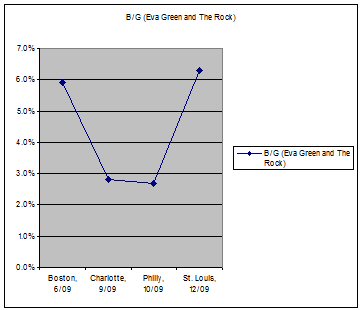
Interestingly, I also suspect that people selected B/G decks for the same reason as Aggro-Loam: they felt that they found a deck that beat Merfolk and Zoo. However, Zoo didn’t show up in very big numbers, even though B/G crushed Merfolk. The problem was that B/G didn’t do as well against the rest of the field, and especially decks like Canadian Threshold.
B/G could have the advantage of being very well positioned in the next tournament. It beats Merfolk and it apparently beats Aggro-Loam. It may be weak to Canadian Threshold, but that isn’t disqualifying.
B/G could be very well positioned. It is good against Merfolk, Aggro-Loam, and can beat CounterTop. It’s only apparently really weak to Ad Nauseam.
Positioning in Legacy
So, how do you win in this environment? Let’s begin to answer this question by asking the question in reverse: What can we rule out, as an initial matter?
1) Graveyard Hate will be at an all time high. That rules out any deck that relies heavily on the graveyard. I would not play Dredge under any circumstances. But I wouldn’t play Entomb Hulk, Reanimator, Land, or Aggro-Loam either. As a corollary, I would make sure that I have plenty of anti-Graveyard hate in my sideboard.
2) I would not play Merfolk, since Zoo exists and is one of the more popular archetypes. Merfolk cannot beat Zoo, it seems. Until it can, I wouldn’t play Merfolk at all. It’s an otherwise decent archetype.
3) I would not play Ad Nauseam. Ad Nauseam crushes almost anything that isn’t blue, and isn’t even that bad against Stax. The problem is that it just can’t beat anything with blue. Ad Nauseam pilots are ignoring the data if they think otherwise, and that’s why it dried up so much. It can’t beat CounterTop, Threshold, or Merfolk. But as a corollary, if I am not playing a Blue deck, I would make sure I have SB hate, like Mindbreak Trap or Chalice, for Ad Nauseam.
Now, in selecting an archetype, you need to meet conditions 1-3, and select a deck that naturally beats: Merfolk, CounterTop, Aggro-Loam, Stax, and can split with Canadian Threshold. If you can do that, you will win SCG LA. However, given these features, I think there is one big, big question you have to decide:
Do you play a major archetype tuned to beat the rest of the field, or do you go rogue, and try an archetype that, like White Stax and Aggro-Loam, previously Rogue archetypes, were well positioned in the metagame to swoop up and win.
If you don’t go rogue, the only three options, it seems to me, are B/G (either Eva Green or The Rock), Junk, or a CounterTop Variant. I don’t think any of the other major archetypes is good enough.
However, as noted, history would seem to suggest that the best chance it so go rogue. So, if you go rogue, which archetype should you play? I think I know.
I actually suspect that Team America may be the perfect metagame deck.
Look at what David Gleicher played:
Creatures (8)
Lands (20)
Spells (32)
- 4 Brainstorm
- 4 Force of Will
- 1 Reanimate
- 1 Smother
- 4 Daze
- 4 Stifle
- 3 Snuff Out
- 4 Ponder
- 4 Thoughtseize
- 3 Spell Pierce
Sideboard

The problem is that he didn’t have enough anti-GY hate, and he lost to Aggro-Loam. I would play Leylines in the sideboard without question. Also, I would definitely play 4 Snuff Out and some Submerges (If not Mind Harnesses) in the sideboard.
Another Rogue option that could be very promising is actually Landstill or a strong control deck, although its design has to be meticulous.
Team America sounds like the way to go. I strongly endorse.
Have a Happy New Year…
PS: It’s interesting to note that only two players at the Legacy event in Philly played in the Legacy Open in St. Louis, and both events still got over 125 players. It seems that Legacy players do not travel very far for these events. It will be interesting to see if large scale regional differences emerge as we enter the SCG Open season.
Also, here is a table that you might find interesting:
| Location | Boston | Charlotte | Philly | St. Louis |
| # players | 185 | 109 | 147 | 128 |
| Archetype | Boston, 6/09 | Charlotte, 9/09 | Philly, 10/09 | St. Louis, 12/09 |
| Merfolk | 11.9% | 11.9% | 5.4% | 8.6% |
| CounterTop-Goyf | 10.8% | 12.8% | 10.9% | 7.8% |
| Zoo | 9.7% | 12.8% | 8.9% | 3.9% |
| Canadian Threshold | 5.9% | 5.5% | 5.4% | 8.6% |
| Goblins | 5.4% | 3.7% | 4.8% | 2.3% |
| Ad Nauseam | 5.4% | 3.7% | 6.1% | 3.9% |
| BGW (PT Junk) | 0.5% | 3.7% | 3.4% | 4.7% |
| B/G | 5.9% | 2.8% | 2.7% | 6.3% |
| Goyf Sligh | 4.3% | 0.0% | 1.4% | 0.0% |
| Dragon Stompy | 3.8% | 1.8% | 2.7% | 0.7% |
| Dreadtill | 3.8% | 4.6% | 4.0% | 1.6% |
| Affinity | 2.7% | 2.8% | 2.0% | 1.6% |
| Landstill | 2.7% | 0.0% | 1.4% | 1.6% |
| Dredge | 2.2% | 5.5% | 4.8% | 11.8% |
| Survival | 2.2% | 0.0% | 2.0% | 1.6% |
| Burn/Sligh | 2.2% | 2.8% | 1.4% | 1.6% |
| Mono-White Stax | 0.5% | 0.9% | 2.0% | 6.3% |
| Aggro Loam | 1.0% | 0.9% | 0.7% | 3.1% |
| 43 Land | 0.5% | 2.8% | 1.4% | 3.1% |
| Elves | 1.6% | 1.8% | 1.4% | 1.6% |
| Belcher | 2.0% | 2.3% | ||
| Team America | 1.4% | 0.8% |
It’s pretty self-explanatory, but this is for the data geeks among us. It shows you the archetype distribution as a percentage of the field at each of the SCG $5Ks so far this year. Use it, if you are daring, to try and predict the LA metagame.
Best of luck in LA.

